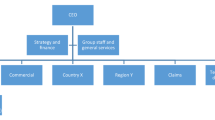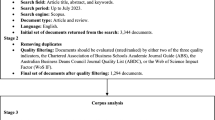Abstract
This paper presents a structural equation model that relates knowledge coordination with access to information in the process of implementing Six Sigma and their impact on the quality and economic benefits obtained. The model integrates four latent variables (knowledge coordination and access to information as independent variables; quality benefits and economic benefits as dependent variables), that are intertwined by five hypotheses validated statistically through the partial least squares technique using data from 301 responses to a survey applied in the maquiladora industry. Findings suggest that to obtain benefits associated with product quality, information and knowledge acquired from Six Sigma, projects must be carefully saved, managed, and analysed with appropriate statistical techniques applied by green and black belts. However, to obtain economic benefits, the information and knowledge must be transformed into benefits associated with quality such as reduction in delivery time, reduction of customer complains and compliance with standards demanded by the customer.


Similar content being viewed by others
References
Swain, A. K., Cao, Q. R., & Gardner, W. L. (2018). Six Sigma success: Looking through authentic leadership and behavioral integrity theoretical lenses. Operations Research Perspectives, 5, 120–132. https://doi.org/10.1016/j.orp.2018.04.001.
Costa, L. B. M., Godinho Filho, M., Fredendall, L. D., & Gómez Paredes, F. J. (2018). Lean, Six Sigma and lean Six Sigma in the food industry: A systematic literature review. Trends in Food Science & Technology, 82, 122–133. https://doi.org/10.1016/j.tifs.2018.10.002.
Westgard, J. O., & Westgard, S. A. (2017). Six Sigma quality management system and design of risk-based statistical quality control. Clinics in Laboratory Medicine, 37(1), 85–96. https://doi.org/10.1016/j.cll.2016.09.008.
Gaikwad, L. M., Teli, S. N., Majali, V. S., & Bhushi, U. M. (2016). An application of Six Sigma to reduce supplier quality cost. Journal of The Institution of Engineers (India): Series C, 97(1), 93–107. https://doi.org/10.1007/s40032-015-0200-2.
Laureani, A., & Antony, J. (2018). Leadership—A critical success factor for the effective implementation of Lean Six Sigma. Total Quality Management & Business Excellence, 29(5), 502–523. https://doi.org/10.1080/14783363.2016.1211480.
Laureani, A., & Antony, J. (2017). Leadership characteristics for Lean Six Sigma. Total Quality Management & Business Excellence, 28(3/4), 405–426. https://doi.org/10.1080/14783363.2015.1090291.
Mustafa, Z., & Jamaluddin, Z. (2017). Six Sigma critical success factors in manufacturing industries. AIP Conference Proceedings, 1830(1), 1–8. https://doi.org/10.1063/1.4981004.
Kwak, Y. H., & Anbari, F. T. (2006). Benefits, obstacles, and future of Six Sigma approach. Technovation, 26(5), 708–715. https://doi.org/10.1016/j.technovation.2004.10.003.
Cima, R. R., Brown, M. J., Hebl, J. R., Moore, R., Rogers, J. C., Kollengode, A., et al. (2011). Use of lean and Six Sigma methodology to improve operating room efficiency in a high-volume tertiary-care academic medical center. Journal of the American College of Surgeons, 213(1), 83–92. https://doi.org/10.1016/j.jamcollsurg.2011.02.009.
Salaheldin, S. I., & Abdelwahab, I. S. (2009). Six Sigma practices in the banking sector in Qatar. Global Business and Management Research: An International Journal, 1(1), 23–35.
Alhuraish, I., Robledo, C., & Kobi, A. (2017). A comparative exploration of lean manufacturing and Six Sigma in terms of their critical success factors. Journal of Cleaner Production, 164, 325–337. https://doi.org/10.1016/j.jclepro.2017.06.146.
Ribeiro de Jesus, A., Antony, J., Lepikson, H. A., & Peixoto, A. L. A. (2016). Six Sigma critical success factors in Brazilian industry. International Journal of Quality & Reliability Management, 33(6), 702–723. https://doi.org/10.1108/IJQRM-08-2014-0120.
Psomas, E. (2016). The underlying factorial structure and significance of the Six Sigma difficulties and critical success factors. TQM Journal, 28(4), 530–546. https://doi.org/10.1108/TQM-04-2015-0049.
Lande, M., Shrivastava, R. L., & Seth, D. (2016). Critical success factors for Lean Six Sigma in SMEs (small and medium enterprises). TQM Journal, 28(4), 613–635. https://doi.org/10.1108/TQM-12-2014-0107.
Ismyrlis, V., & Moschidis, O. (2013). Six Sigma’s critical success factors and toolbox. International Journal of Lean Six Sigma, 4(2), 108–117. https://doi.org/10.1108/20401461311319310.
Habidin, N. F., & Yusof, S. R. M. (2013). Critical success factors of Lean Six Sigma for the Malaysian automotive industry. International Journal of Lean Six Sigma, 4(1), 60–82. https://doi.org/10.1108/20401461311310526.
Desai, D. A., Antony, J., & Patel, M. B. (2012). An assessment of the critical success factors for Six Sigma implementation in Indian industries. International Journal of Productivity & Performance Management, 61(4), 426–444. https://doi.org/10.1108/17410401211212670.
Tlapa, D., Limón, J., Baez, Y., & Valles-Rosales, D. J. (2015). Critical success factors of Six Sigma: An overview. In 2014 IEEE international conference on industrial engineering and engineering management, bandar sunway (pp. 818-822), Malaysia, 9–12 December 2014. IEEE Xplore. https://doi.org/10.1109/IEEM.2014.7058752.
Brun, A. (2011). Critical success factors of Six Sigma implementations in Italian companies. International Journal of Production Economics, 131(1), 158–164. https://doi.org/10.1016/j.ijpe.2010.05.008.
Revere, L., Kadipasaoglu, S. N., & Zalila, F. (2006). An empirical investigation into Six Sigma critical success factors. International Journal of Productivity and Quality Management, 1(3), 224–252. https://doi.org/10.1504/IJPQM.2006.008476.
Hagspiel, S. (2018). Reliability with interdependent suppliers. European Journal of Operational Research, 268(1), 161–173. https://doi.org/10.1016/j.ejor.2018.01.014.
Fairul-Anwar, A., & Mohd Amran, M. (2015). Critical success factors of Lean Six Sigma deployment: A current review. International Journal of Lean Six Sigma, 6(4), 339–348. https://doi.org/10.1108/IJLSS-04-2015-0011.
Tenera, A., & Pinto, L. C. (2014). A Lean Six Sigma (LSS) project management improvement model. Procedia - Social and Behavioral Sciences, 119, 912–920. https://doi.org/10.1016/j.sbspro.2014.03.102.
Boon Sin, A., Zailani, S., Iranmanesh, M., & Ramayah, T. (2015). Structural equation modelling on knowledge creation in Six Sigma DMAIC project and its impact on organizational performance. International Journal of Production Economics, 168, 105–117. https://doi.org/10.1016/j.ijpe.2015.06.007.
Shafer, S. M., & Moeller, S. B. (2012). The effects of Six Sigma on corporate performance: An empirical investigation. Journal of Operations Management, 30(7), 521–532. https://doi.org/10.1016/j.jom.2012.10.002.
Ertürk, M., Tuerdi, M., & Wujiabudula, A. (2016). The effects of Six Sigma Approach on business performance: A study of white goods (home appliances) sector in Turkey. Procedia - Social and Behavioral Sciences, 229, 444–452. https://doi.org/10.1016/j.sbspro.2016.07.154.
García-Alcaraz, J., Alor-Hernández, G., Sánchez-Ramírez, C., Jiménez-Macías, E., Blanco-Fernández, J., & Latorre-Biel, J. (2018). Mediating role of the Six Sigma implementation strategy and investment in human resources in economic success and sustainability. Sustainability, 10(6), 1828. https://doi.org/10.3390/su10061828.
Gutierrez Gutierrez, L., Barrales-Molina, V., & Tamayo-Torres, J. (2016). The knowledge transfer process in Six Sigma subsidiary firms. Total Quality Management & Business Excellence, 27(5/6), 613–627. https://doi.org/10.1080/14783363.2015.1032237.
García-Alcaraz, J., Avelar-Sosa, L., Latorre-Biel, J., Jiménez-Macías, E., & Alor-Hernández, G. (2017). Role of human knowledge and communication on operational benefits gained from Six Sigma. Sustainability, 9(10), 1721. https://doi.org/10.3390/su9101721.
Jevgeni, S., Shevtshenko, E., & Karaulova, T. (2013). Data mart with lean Six Sigma concept for performance level assessment in knowledge management frame. In European conference on knowledge management (Vol. 2, pp. 932–941)
Lin, C., Frank Chen, F., Wan, H.-D., Min Chen, Y., & Kuriger, G. (2013). Continuous improvement of knowledge management systems using Six Sigma methodology. Robotics and Computer-Integrated Manufacturing, 29(3), 95–103. https://doi.org/10.1016/j.rcim.2012.04.018.
White, M., García, J. L., Hernández, J. A., & Meza, J. (2009). Cycle time improvement by a Six Sigma project for the increase of new business accounts. International Journal of Industrial Engineering: Theory Applications and Practice, 16(3), 191–205.
Bañuelas, R., Antony, J., & Brace, M. (2005). An application of Six Sigma to reduce waste. Quality and Reliability Engineering International, 21(6), 553–570. https://doi.org/10.1002/qre.669.
Zhang, W., & Xu, X. (2008). Six Sigma and information systems project management: A revised theoretical model. Project Management Journal, 39(3), 59–74. https://doi.org/10.1002/pmj.20066.
Mitchell, E. M., & Kovach, J. V. (2016). Improving supply chain information sharing using design for Six Sigma. European Research on Management and Business Economics, 22(3), 147–154. https://doi.org/10.1016/j.iedee.2015.02.002.
Marinagi, C., Trivellas, P., & Reklitis, P. (2015). Information quality and supply chain performance: The mediating role of information sharing. Procedia - Social and Behavioral Sciences, 175, 473–479. https://doi.org/10.1016/j.sbspro.2015.01.1225.
Marra, M., Ho, W., & Lee, C. K. M. (2016). Managing supply chain knowledge-based linkages for improving operational performance. Knowledge Management Research & Practice, 14(3), 256–269. https://doi.org/10.1057/kmrp.2014.28.
Chakravorty, S. S. (2009). Six Sigma failures: An escalation model. Operations Management Research, 2(1), 44. https://doi.org/10.1007/s12063-009-0020-8.
Erbiyik, H., & Saru, M. (2015). Six Sigma implementations in supply chain: An application for an automotive subsidiary industry in Bursa in Turkey. Procedia - Social and Behavioral Sciences, 195, 2556–2565. https://doi.org/10.1016/j.sbspro.2015.06.447.
Deeb, S., Haouzi, H. B.-E., Aubry, A., & Dassisti, M. (2018). A generic framework to support the implementation of Six Sigma approach in SMEs. IFAC-PapersOnLine, 51(11), 921–926. https://doi.org/10.1016/j.ifacol.2018.08.490.
de Freitas, J. G., Costa, H. G., & Ferraz, F. T. (2017). Impacts of Lean Six Sigma over organizational sustainability: A survey study. Journal of Cleaner Production, 156, 262–275. https://doi.org/10.1016/j.jclepro.2017.04.054.
Arumugam, V., Antony, J., & Linderman, K. (2016). Decision support: The influence of challenging goals and structured method on Six Sigma project performance: A mediated moderation analysis. European Journal of Operational Research, 254, 202–213. https://doi.org/10.1016/j.ejor.2016.03.022.
Kock, N. (2018). WarpPLS 6.0 user manual. Laredo, TX, USA: ScriptWarp Systems.
Kock, N., Verville, J., Danesh-Pajou, A., & DeLuca, D. (2009). Communication flow orientation in business process modeling and its effect on redesign success: Results from a field study. Decision Support Systems, 46(2), 562–575. https://doi.org/10.1016/j.dss.2008.10.002.
Avelar-Sosa, L., Garcia-Alcaraz, J. L., Maldonado-Macias, A. A., & Mejia-Munoz, J. M. (2018). Application of structural equation modelling to analyse the impacts of logistics services on risk perception, agility and customer service level. Advances in Production Engineering & Management, 13(2), 179–192. https://doi.org/10.14743/apem2018.2.283.
Díaz-Reza, J., García-Alcaraz, J., Avelar-Sosa, L., Mendoza-Fong, J., Sáenz Diez-Muro, J., & Blanco-Fernández, J. (2018). The role of managerial commitment and TPM implementation strategies in productivity benefits. Applied Sciences, 8(7), 1153. https://doi.org/10.3390/app8071153.
García-Alcaraz, J. L., Prieto-Luevano, D. J., Maldonado-Macías, A. A., Blanco-Fernández, J., Jiménez-Macías, E., & Moreno-Jiménez, J. M. (2015). Structural equation modeling to identify the human resource value in the JIT implementation: Case maquiladora sector. International Journal of Advanced Manufacturing Technology, 77(5–8), 1483–1497. https://doi.org/10.1007/s00170-014-6561-5.
Zou, X. P. T., & Lee, W. B. (2010). A study of knowledge flow in Six Sigma teams in a Chinese manufacturing enterprise. VINE: The Journal of Information & Knowledge Management Systems, 40(3/4), 390–403. https://doi.org/10.1108/0305572101107148.
Author information
Authors and Affiliations
Corresponding author
Ethics declarations
Conflicts of interest
The authors declare no conflicts of interest.
Additional information
Publisher's Note
Springer Nature remains neutral with regard to jurisdictional claims in published maps and institutional affiliations.
Rights and permissions
About this article
Cite this article
García-Alcaraz, J.L., Montalvo, F.J.F., Avelar-Sosa, L. et al. The importance of access to information and knowledge coordination on quality and economic benefits obtained from Six Sigma. Wireless Netw 26, 5713–5726 (2020). https://doi.org/10.1007/s11276-019-02180-7
Published:
Issue Date:
DOI: https://doi.org/10.1007/s11276-019-02180-7




